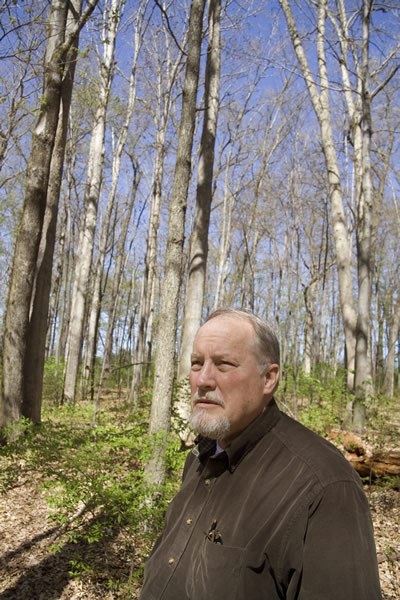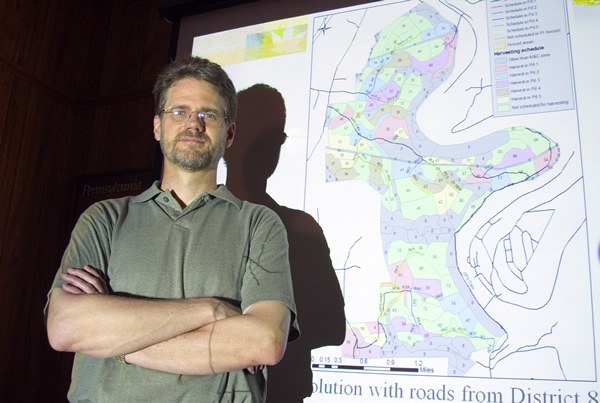Dr. Kim Steiner, professor of forest biology, designed the oak regeneration study that has been under way since 1996. As a result of the research, scientists are beginning to understand why oaks are not regenerating.

Dr. Kim Steiner in an oak regeneration forest, Photo by Gordon Harkins
Our state's forests have evolved over thousands of years or more. This resource is a complex ecological system, supporting both terrestrial and aquatic species, and having the dynamic character of changing its composition over time. In a parallel fashion, forest-related research evaluates the existing character and composition of the resource, and the interplay of various factors or elements that influence the forest over time. These investigative efforts can also establish appropriate management approaches to influence the yield of products and services, and the eventual ecological or aesthetic attributes of the future forest.
Within Pennsylvania and other eastern states, there is a noted expansion of red maple in the forests. This inroad has been made at the expense of oak species, which have suffered from gypsy moth attacks, other diseases, and ongoing harvests. This ecological transition was identified by Dr. Marc Abrams, professor of forest ecology, in an early treatise that identified red maple's biological advantages within hardwood forests and its expansion within many of our eastern forests. Originally, because of its sensitivity to fire, red maple was relegated to the swamps. But with the gradual suppression of forest fires, red maple has emerged to take over upland sites and can be found on many of the landscapes in the eastern deciduous forest. Dr. Abrams also benchmarked earlier impacts imposed upon these forests by Native Americans in their casual use and management of certain forest and field settings.
Dr. Margot Kaye, assistant professor of forest ecology, believes that various forest types might be more effectively managed with controlled burns on a case-by-case basis. Her previous experience with western forests provides an interesting backdrop for using fire to encourage certain regeneration and growth responses found among various species within the collection of eastern deciduous forests. State officials are now looking at modifying liability laws to enable controlled forest burning.
In an effort to better define ways and means for sustaining oak species in their existing stands, Dr. Kim Steiner, professor of forest biology, and Dr. James Finley, professor of forest resources, established a longitudinal study of oak stand development within central Pennsylvania. One conclusion from their research is that conditions at the time of harvest play a major role in the development of the future oak stand. To achieve reliable regeneration, fencing of oak stands to keep deer out should occur before harvest. The study has also disproved a widespread notion that oak seedlings must be large at the time of overstory harvest in order to succeed in the next stand. Quantity can make up for size, because the forest environment is not homogenous. Some small seedlings start out in advantageous conditions and can survive the early battle for space.
Dr. William Sharpe, professor of forest hydrology, has chronicled the effects of acid rain in Pennsylvania for several decades and also has watched red oaks decline and red maples become predominant. His explanation for the trend is that soils in many places have become too acidic to support adequate growth of red oak. Dr. Sharpe completed several research projects that suggest soil acidification may be responsible for the rising fortunes of red maple. In a simulated deer-browsing study, red maple grew better after simulated browsing than red oak, and in plant bioassays, red maple was much less sensitive to aluminum and low calcium than red oak. In studies done at Penn State in the 1970s, deer actually preferred to browse red maple over red oak, so Dr. Sharpe does not subscribe to the hypothesis that deer are the only reason for red maple's success.
With reference to developing actual management tools, Dr. Marc McDill, associate professor of forest resource management, has developed forest-management computer models now being used by the Pennsylvania Department of Conservation and Natural Resources' Bureau of Forestry to guide tree harvests on 2.1 million acres of state forestland. The goal is to help the people who manage the forests do the best job that they can. The computer models show how things work in the forest over time. These models are based on data, and where actual data does not exist, assumptions are made based on the best information available. The models are explicit, and the assumptions can be changed to see how they affect the outcomes.
Using Dr. McDill's software, foresters can determine the best approach for harvesting patterns among mature forests and the sequence of patterns over time, thereby shaping a desired forest for the future. "Right now, our forests are more or less the same age," Dr. McDill says. "We need to get a better age distribution. Stands of trees might be even-aged, but the idea is to get a mix of stands across the forest. We are planning generations ahead."
Dr. Eric Zenner, associate professor of silviculture, shares this interest in managing and planning for the future forest. Given the mature status of most of Pennsylvania's existing forest, Dr. Zenner is evaluating the most efficient method by which old stands can be converted and regenerated to new stands, while, at the same time, maintaining the quality and diversity of these forests over time. This requires a synthesis of silvicultural information on the ecology of existing forests, their growing sites, the harvesting methods or biological phenomena surrounding their harvest or loss, and the regenerative probabilities of certain key species. Again, these efforts will require computerized models and an adaptation of spatial and temporal parameters toward the conversion process.


